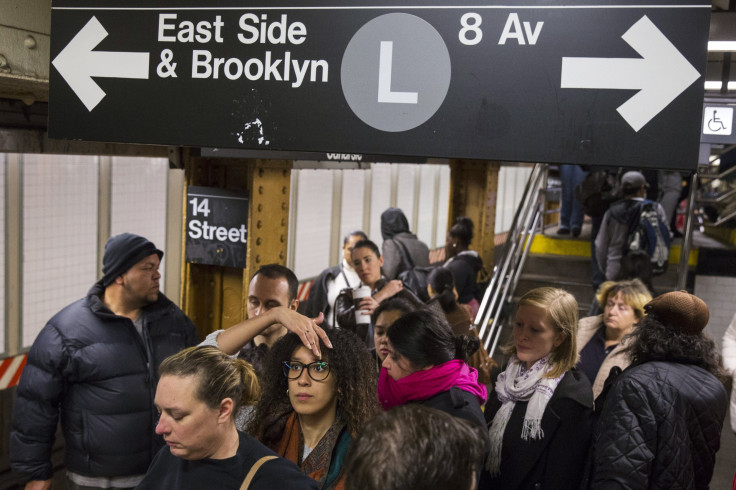Ebola In NYC: Why New Yorkers Shouldn't Worry

At first glance, New York City seems like the worst place for the Ebola virus to surface. The city is the most densely populated metropolitan area in the United States, around 5.5 million people ride the New York City subway every weekday, and New Yorkers are constantly in contact with germs on public trains, at food carts and while simply walking down the street. With the city's first Ebola patient being treated in Manhattan, the question on everybody’s mind is: “Should I be worried yet?”
“At this point, no,” Dr. Eden Wells of the University of Michigan’s School of Public Health said. “The risk for contact to a citizen outside of a person in the health care system caring for an infected patient is low, if not very low.”
The city recieved a shock late Thursday when Mayor Bill de Blasio announced that Dr. Craig Spencer, a local doctor, tested positive for Ebola and was being treated at Bellevue Hospital in Manhattan. Spencer treated Ebola patients in Guinea with Doctors Without Borders. He was home for about a week and reported feeling unwell prior to being put in isolation. “It is a global city, we knew that one day we would get a patient with Ebola,” said Dr. Ram Raju, President and CEO of New York City Health and Hospitals Corporation, during a press conference Friday.
New York City offers some unique challenges given its population, but the city is not as vulnerable to the conditions that led to a widespread outbreak in West Africa, where nearly 5,000 people have died from Ebola. West Africa buckled under the weight of Ebola largely because of weak health care systems. In contrast, New York City has one of the strongest public health systems in the country, and public officials have been informed of the potential risk for weeks. Bellevue Hospital, where all cases of the virus will be sent, has trained its staff to deal with Ebola cases for two and half months.
Unlike the case of Thomas Eric Duncan, the Dallas patient who became the first person to die of Ebola in the U.S. this month, Spencer wasn't showing signs beyond a slight fever before going into quarantine, mostly thanks to his own initiative. City officials quarantined Spencer’s fiancée and two friends as a precaution, but all three were healthy.
City health officials tracked Spencer's movements using his cell phone. He reportedly went to a coffee shop, a restaurant, a bowling alley, took two trains and an Uber cab before being quarantined. All but the restaurant, the Meatball Shop in Manhattan, are back open for business on Friday. His apartment in Harlem will be decontaminated, which at the very least, involves cleaning with bleach solution and disposing of potentially tainted materials.
New Yorkers going out this weekend shouldn't be worried because the virus can only survive for a few hours on hard surfaces such as a subway train pole or a bowling ball. Even so, the Metropolitan Transportation Authority has upgraded its cleaning protocols. MTA employees will now use "nitrile gloves, use a 10 percent bleach solution for disinfection and double-bag any potentially infectious waste," according to an MTA press release.
To contain the spread of the virus in New York, health officials must undertake swift and comprehensive contact tracing, Wells said. "In an urban area that’s going to be much more intense and complicated, because people move more quickly and do so en masse compared to a rural or suburban setting," he said. "The work is really cut out for [health authorities].”
Contact tracing was key to halting outbreaks in Nigeria and Senegal, while a failure to trace contacts greatly exacerbated the outbreaks in Sierra Leone, Guinea and Liberia, which were also vulnerable because of limited access to education and hard-to-reach hot spots.
On Wednesday, federal health officials began requiring anyone who traveled to the three West African nations that have been hit the hardest with Ebola outbreaks to leave contact info and check in daily with health officials for 21 days, the incubation period of the virus, allowing officials to immediately jump on any potential case.
The people most at risk are health workers that treat Spencer or any other cases of the disease. Improper protocol caused two Dallas nurses to be infected while treating Duncan at Texas Health Presbyterian Hospital. That hospital wasn’t trained to deal with the virus, but Bellevue workers have been training for two and half months. Officials said they were confident that there wouldn’t be any issues.
So when should New Yorkers start to worry? A major warning sign is if community members who came into contact with Spencer or any other case become infected, Dr. Wells said. That means the virus is reaching beyond health care workers. Wells said that this possibility was low and pointed to the failure of the virus to spread to Duncan’s family in Texas, even when he was contagious.
"It’s natural for people to ask, 'what does this mean for me?' -- and it is a public health concern," she said. "Frankly, New York City is a wonderful model for that kind of work.... You've certainly got a whole lot of experts and doctors in the health system there; that’s the silver lining."
© Copyright IBTimes 2024. All rights reserved.






















